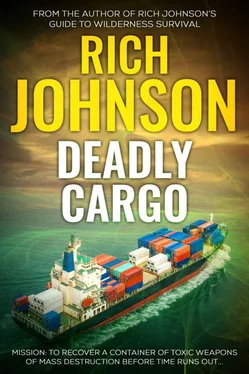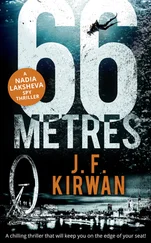Solid overcast blanketed the sky, and the water was the color of new steel. A persistent swell from just ahead of the starboard beam rolled the huge ship slowly. It was a slow, lazy motion that was not yet uncomfortable for the crew on a ship the size and displacement of Desdemonda. Still, Sleagle was worried. This was not the usual swell, and he knew that it foretold the fury of a powerful storm still to the east and heading his way. The winds were already howling through the ship’s superstructure. His instruments indicated a wind speed of 58 knots, gusting to 63. No, this was not at all normal for this time of year in the southwestern corner of the Caribbean Sea.
Sleagle was one of those men who had discovered his calling in life at an early age. He was a man of the sea, not only by career choice, but also as the fulfillment of a dream he held since childhood. He grew up reading sea tales, some fictional and some true. He was certain that, as with all tales of the sea, even the ones that claimed to be true, were embellished with a modicum of editorial license. Now, as he stood at the helm and considered what was coming at him, he recalled the story of a brigantine named Tesoro do Rei that was lost not far from here back in 1571.
As the tale went, the ship set sail for its home port in Portugal in late October, loaded with booty stolen or otherwise obtained from the natives of what is now Guatemala. Three days after weighing anchor and heading into open sea, a powerful hurricane ripped the ship apart and she sank with all hands.
The following year, men aboard another ship sailing toward the mainland saw smoke rising from a tiny island off present day Honduras. The captain ordered the sails down and sent a party ashore to investigate. They discovered Guillermo Ascente, former commander of Tesoro do Rei, living the life of a castaway in a primitive hut, wearing rags, skinny and almost lifeless, eating whatever he could scrounge from the jungle and the sea.
After returning to Portugal, Ascente became somewhat of a local hero as he told his story of surviving the hurricane that came to be known as ‘O Gigante’.
“Sir,” the voice of his first officer brought Sleagle back from his thoughts, and he turned to face the man.
“Yes, what is it?”
“A report from the deck crew, sir. They have checked all the tie-downs and found everything secure.”
“Thank you. Carry on.”
The bridge deck was elevated the height of a two-story building above the highest rank of containers, and was positioned near the stern of the ship, giving the skipper a commanding view of his cargo load. The bridge deck was a wide glass and steel hallway that stretched ninety-two feet across the ship, and was filled with the latest electronic monitoring, control, communication and navigation equipment. There were dedicated stations for the other members of his command team, consisting of his first officer and navigator. To port and starboard of the enclosed bridge, outside platforms offered secondary stations where the skipper could see up and down the length of the ship to either side and direct steerage and line-handling when docking, passing through locks, or when tugs were coming alongside. In some respects, the view from the bridge deck was like watching a football game from the owner’s lounge through an expanse of windows high above the field.
Facing the command team were redundant arrays of monitors for the multiple radar and electronic chart plotting systems. Primary and secondary VHF and SSB radios, as well as the ship’s intercom system, were centered on the command dashboard.
The helm station was home to the engine controls and the vast array of electrical and hydraulic systems controls. Rather than having a wheel, Desdemonda’s manual steering was controlled by use of devices similar to computer game joysticks. Rudder angle indicators gave a visual feedback to the captain about how much steering effort was being made.
Manual steering was used for close-in work, but most of the time, the huge ship was steered by autopilot that was directed electronically by the global positioning satellite system, leading the vessel from one pre-designated waypoint to the next without the need for anyone to touch the controls.
On the open sea, the ship could literally tend itself while everyone on board went to sleep or fell overboard or died of carbon monoxide poisoning. Once the ship was underway and the autopilot activated, nothing would stop it from plowing ahead at full speed toward its destination. To Sleagle, all the electronic gadgetry came with both a bright and a dark side. It certainly eased the exhausting burden of having to manually control the ship hour after hour, day after day, as it had been done in earlier times before the advances of technology. But if the crew became complacent and lazy, the self-governing systems could carry the ship to disaster. Sleagle constantly reminded the command team that even with all the wizardry built into the control systems, it was still necessary, in fact it was the law of the sea, that the command crew maintain an adequate watch at all times.
“Machines and electronics are nice,” he was fond of saying, “but they can’t make judgment calls or respond to sudden emergencies the way a man at the helm can.”
Much of the time, only one member of the command team stood watch. They worked by a three-on, six-off schedule leaving the off-watch ample time to rest and prepare for their shift. But today, as they prepared to head into the hurricane, all hands were on the bridge deck, and would stay there until the captain decided to shorten crew and resume the rotation schedule. This was one of those exceptional moments in the life of a container ship, when every set of eyes and ears was necessary for the next several hours as they sailed into harm’s way.
The rest of the crew, consisting of twenty-nine men, were scattered throughout the ship, tending to cargo and mechanical equipment. A full team of ship’s engineers stood round-the-clock watch on the engines and generators. Electricians and hydraulic specialists saw to the needs of the onboard electrical and hydraulic equipment. Others pulled shifts to maintain saltwater desalination units that provided fresh water for the ship. A mess crew kept everybody fed, and a gang of able seamen took care of general ship’s maintenance, scraping and painting and fixing whatever needed attention.
Running all of this was a daunting task. In addition to commanding from the helm, it was Sleagle’s job to make sure the entire ship was kept in top running condition, the crew well fed and cared for, and the cargo carried safely to its final destination. It took coordinated teamwork to make it all happen, and he was pleased with the team aboard Desdemonda for this voyage.
As he stared through the binocular at the gray scene before him, Sleagle called for Peter Moyes, his weather officer. A young man of slight build and a thinning wisp of blond hair stepped from a small room directly aft of the helm station. Without turning to acknowledge the man’s presence, Sleagle asked, “What is the latest position of Yolanda?”
Moyes was twenty-three years old, had a weak chin, and his attempt at growing a mustache had failed miserably. The thin hairs on his upper lip were spotty and limp, but he persisted in letting the thing grow, to the amusement of the crew members who sported more substantial facial hair. Looking a bit more pale than usual, Moyes stepped beside the captain.
“The eye is located seventy miles distant at a relative bearing of one two zero and approaching at a speed of 12 knots and rising. We are under the leading edge and on a collision course, sir.”
Sleagle raised his eyebrows. “Well, so much for being stalled. I guess it was too much to hope that she would sit still forever. I was hoping to get out ahead of her and beat her through the Yucatan Channel. The problem is that now that she’s on the move, as the seas grow we’re not going to be able to maintain our speed, so we can’t outrun her. Eventually, we have to slow down and let her pass over us.”
Читать дальше












